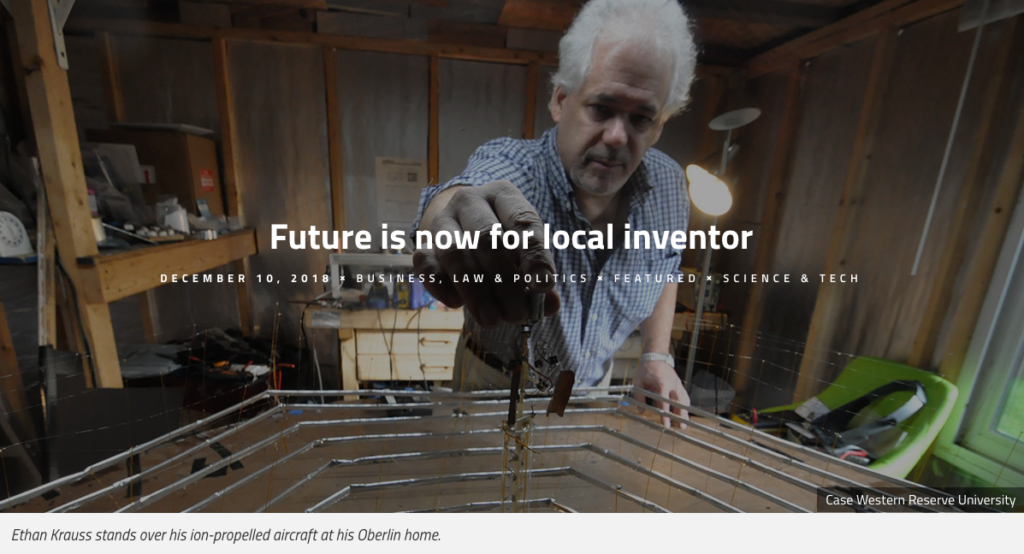
DECEMBER 10, 2018 BUSINESS, LAW & POLITICSFEATUREDSCIENCE & TECH
Oberlin man patents ion-propelled aircraft with help from the Ohio Patent Pro Bono Program and CWRU’s IP Venture Clinic
Many experts agree the future of flight will rely on zero-emission and/or renewable energy technology. That is, aircraft will be propelled by ions—electrically charged molecules—that create thrust in their wake.
But Northeast Ohio inventor Ethan Krauss says the technology is already here. In fact, he’s invented an aircraft that flies silently, with no moving parts, and no emissions.
“People think this is something that we will do in the future,” he said. “I’ve done it now.”
Krauss recently obtained a U.S. patent for his ion-propelled aircraft with help from volunteer attorneys as part of the Ohio Patent Pro Bono Program and Case Western Reserve University School of Law’s IP Venture Clinic (IPVC)—where startup companies, entrepreneurs and “garage inventors” throughout Ohio can get free legal service to obtain a patent for their intellectual property (IP).
“I’ve been working on this for 18 years,” said Krauss, 55, of Oberlin. “When I was a kid, I’d order plans for hang-gliders and hovercraft from Popular Science magazine; I would build them. I started to design my own vehicles from there. I built solar-powered vehicles when I was in my 20s.”
At the very least, Krauss thinks his aircraft could find a market in the toy sector. At best, the technology could revolutionize the future of flight.
“It looks like a magic trick, an amazing demonstration of physics in action,” Krauss said. “It feels like science fiction come true.”
Here’s how it works: Krauss discharges electrical current between two electrodes—one larger than the other—creating wind in the air between. With enough voltage, the resulting wind produces thrust without the help of motors or fuel.
This phenomenon, technically called electrohydrodynamic thrust—or colloquially “ionic wind”—has been around for decades. Krauss came across a 1964 patent for an “ion-propelled aircraft.”
He’s not the first to try it. For years, hobbyists and basement enthusiasts have built lightweight crafts that can fly, but the attached power sources were too heavy to stay onboard.
So, literally, the idea couldn’t get off the ground. Until now. Krauss’s patent specifically covers “ion-powered vehicles carrying their own power supply.”
Krauss, who by day teaches guitar classes at the Strongsville Academy of Music, studied electrical engineering in college years ago. It’s been a hobby-turned-passion since.
Now, with a working prototype, he’s enthusiastically looking to take the idea to the next level, but didn’t have the resources or the know-how to legally protect his idea.
Enter the law school’s IP Venture Clinic and the Ohio Patent Pro Bono Program.
Krauss has been working with volunteer patent attorneys Rich Wesorick and Brian Bolinger from Tarolli, Sundheim, Covell & Tummino in Cleveland to prepare and file a patent application for his invention. Starting last year, the IPVC began working with Krauss to form a new business (Electron Air LLC) and start the process of approaching potential investors.
The legal help has been a big boost, he said.
Under the umbrella of the IPVC, inventors can file and secure a patent, while maintaining attorney/client privilege to keep their ideas legally protected. The program recruits inventors and patent lawyers statewide, matching them based on the invention and an attorney’s expertise.
“This is how these programs work together,” said Ted Theofrastous, Managing Attorney of the IPVC and Chairman of the Ohio Patent Pro Bono Program. “Inventors do not have the resources or knowhow necessary to prepare and file a patent application and see the complex process through. Now that Mr. Krauss has a solid invention, we helped him stand up a new venture around his technology that can, hopefully, take advantage of our regional venture ecosystem.”
Krauss’s hexagonally shaped prototype, thin and lightweight, is tethered to a table (not a power supply) in his workshop. He’s got to be careful: the 4-foot frame may be a bit too fragile to be turned loose outside.
The craft harkens back to a time when the Wright brothers used thin wood, canvas and spare parts for their early airplanes.
“You’ve got to start somewhere,” Krauss said. “We’ve got this device fully operational, now it can really take off.”
For more information, contact Colin McEwen at colin.mcewen@case.edu.
This article was originally published Nov. 23, 2018.
Original article found here: https://thedaily.case.edu/future-now-local-inventor/
